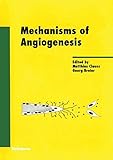Mechanisms of Angiogenesis / edited by Matthias Clauss, Georg Breier.
Tipo de material: TextoSeries Experientia SupplementumEditor: Basel : Birkhäuser Basel, 2005Descripción: xiv, 307 páginas recurso en líneaTipo de contenido:
TextoSeries Experientia SupplementumEditor: Basel : Birkhäuser Basel, 2005Descripción: xiv, 307 páginas recurso en líneaTipo de contenido: - texto
- computadora
- recurso en línea
- 9783764373115
- R-RZ
Springer eBooks
Basic principles in physiological and pathophysiological angiogenesis -- How do endothelial cells orientate? -- New insights into intussusceptive angiogenesis -- Angiogenesis in the female reproductive system -- Arterialization, coronariogenesis and arteriogenesis -- Sprouting angiogenesis versus co-option in tumor angiogenesis -- Hormones and the neovascularization process: role of angiotensin II -- Can tumor angiogenesis be inhibited without resistance? -- Cellular and physical mechanisms of blood vessel growth -- Role of pericytes in vascular morphogenesis -- Role of monocytes and macrophages in angiogenesis -- Bone marrow-derived endothelial progenitor cells for neovascular formation -- Can angiogenesis be exercised? -- Angiogenesis — a self-adapting principle in hypoxia -- Cellular mechanisms of arteriogenesis -- Balancing luminal size and smooth muscle proliferation — a key control point in atherosclerosis and arteriogenesis -- Molecular mechanisms of angiogenesis -- The role of VEGF in the regulation of physiological and pathological angiogenesis -- The anti-inflammatory actions of angiopoietin-1 -- The hemostatic system in angiogenesis -- Signal transduction in angiogenesis.
The induction of blood vessel growth as part of an adaptive process can be either exaggerated, such as in tumors, or too slow, as in ischemic diseases of heart and brain. Therefore it is an interesting target for medical intervention. This volume presents a thorough reconsideration of our current knowledge of factors and principles involved in angiogenic processes. It proceeds from a "macroscopic " perspective through cellular and physical mechanisms to the molecular level . In the first part, angiogenesis in physiological as well as pathological processes is described with a focus on embryogenesis, the reproductive system and the growing heart. The second part deals with cellular and physical mechanisms leading to angiogenesis, and the last part presents a deeper insight into molecular mechanisms of blood vessel growth, including knockout studies of essential angiogenic molecules, the identification of signaling steps in angiogenesis and the importance of cellular junctions.
Para consulta fuera de la UANL se requiere clave de acceso remoto.


